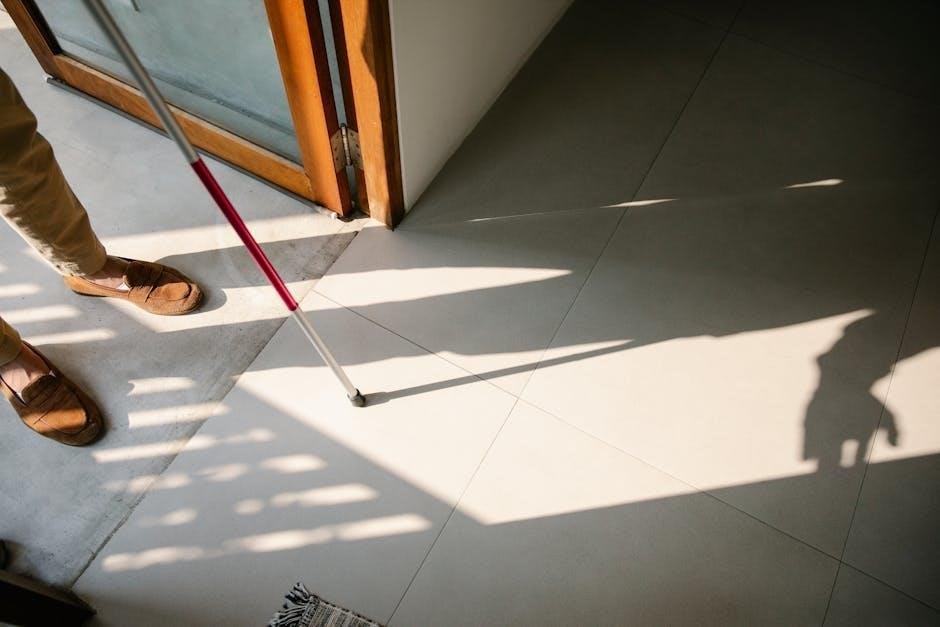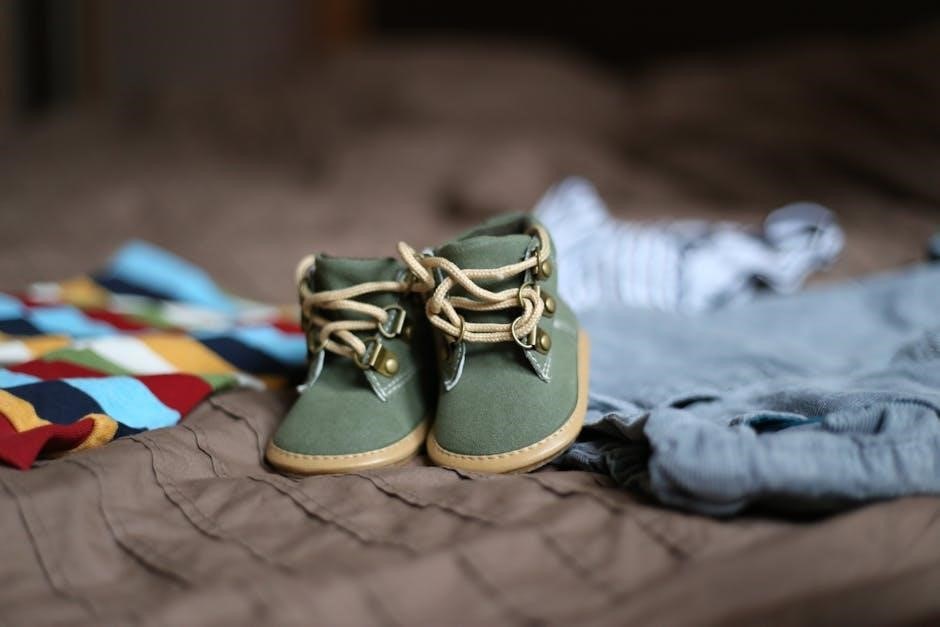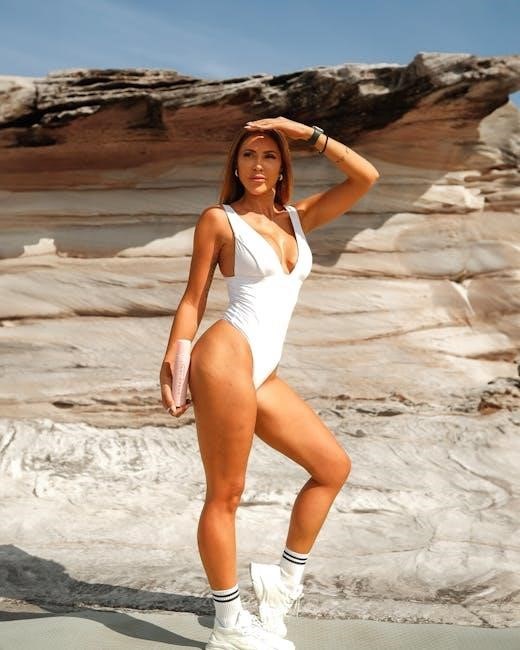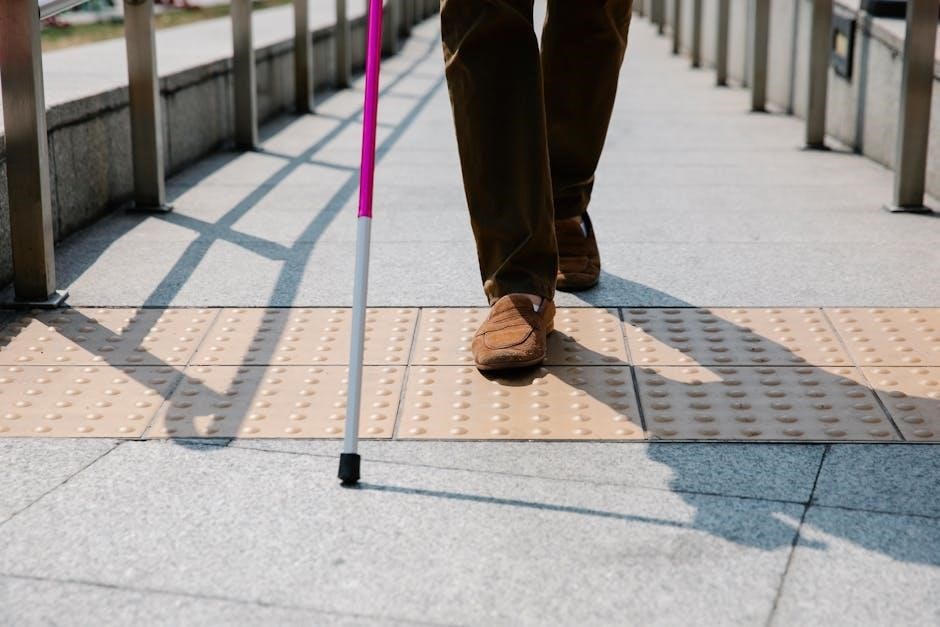Crib shoes are essential for babies’ foot health, supporting natural growth and development. They protect tiny feet while offering comfort and stability during early walking stages.

How to Measure Your Baby’s Foot Length
Measure your baby’s foot length by placing their foot flat on a ruler, ensuring the heel is aligned. Record from the longest toe to the back of the heel.
How to Measure at Home
To measure your baby’s foot length at home, place their foot flat on a ruler or measuring tape. Ensure the heel aligns with the start of the ruler. Gently press the foot down to flatten it slightly. Measure from the back of the heel to the tip of the longest toe. Use a flexible ruler for accuracy if possible. Record the measurement in both inches and centimeters for reference. Repeat the process for both feet, as they may differ slightly. Compare the measurements to a crib shoe size chart to determine the best fit. Always consider growth room for comfort and proper development. This method ensures accuracy and convenience at home.
Understanding Crib Shoe Size Charts
Crib shoe size charts provide standard measurements to ensure proper fit. Sizes typically range from 0 to 6, with each size corresponding to specific foot lengths in inches or centimeters. These charts help match foot measurements to appropriate shoe sizes, ensuring comfort and support for growing feet. Always refer to a size chart when selecting crib shoes to guarantee the best fit for your baby’s foot length and width.
How Crib Shoe Sizing Works
Crib shoe sizing operates on a numerical scale, typically ranging from size 0 to 6, with each size corresponding to specific foot length measurements; These measurements are usually provided in inches or centimeters and are designed to align with the average growth patterns of a baby’s feet. Some brands also offer half sizes to ensure a more precise fit. The sizing system is standardized to help parents choose shoes that provide adequate support and comfort. By consulting a size chart, parents can match their baby’s foot length to the appropriate shoe size, ensuring a comfortable and healthy fit during early walking stages.

Factors to Consider for the Perfect Fit
Key factors include comfort, support, and breathability. Ensure proper toe room and a snug heel fit without constriction. Consider soft, flexible materials that promote natural foot movement.
Key Considerations for Sizing
Accurate foot measurement is crucial for proper sizing. Use a size chart to align foot length with the correct crib shoe size. Ensure there’s room for growth, typically 1/2 inch. Opt for shoes with adjustable closures for a secure fit. Consider the shoe’s width and depth, as babies’ feet vary in shape. Soft, flexible materials promote natural foot movement. Avoid overly tight or loose shoes, as they can cause discomfort or blisters. Seasonal factors, like thicker socks, may affect sizing. Double-check measurements regularly, as babies’ feet grow quickly. Consult brand-specific guides, as sizes can vary slightly between manufacturers. Proper sizing ensures comfort and supports healthy foot development.
How to Choose the Right Crib Shoes
Select crib shoes by measuring your baby’s foot length and matching it to the size chart. Opt for soft, breathable materials and secure closures for comfort and support.
Top Tips for Selecting the Best Crib Shoes
- Measure Accurately: Always measure your baby’s foot length to ensure the right fit. Use a size chart for precise selection.
- Material Matters: Choose soft, breathable fabrics like leather or cotton for comfort and to prevent moisture buildup.
- Check Flexibility: Opt for shoes with flexible soles to support natural foot movement and early walking stages.
- Secure Closures: Ensure shoes have secure closures, like Velcro or laces, to prevent slipping off during activities;
- Style for Purpose: Select styles suited for the occasion—soft-soled for indoor use and sturdier options for outdoor adventures.
Common Mistakes to Avoid When Sizing
Avoid guessing sizes without measuring and ignore outdated size charts. Don’t assume previous sizes fit; feet grow rapidly. Always check fit before purchasing.
Mistakes Parents Often Make
- Guessing sizes without measuring the baby’s foot length accurately.
- Assuming the same size will fit for an extended period without regular checks.
- Ignoring the importance of width measurements, leading to tight or loose shoes.
- Not considering seasonal changes, like thicker socks in winter, when sizing.
- Choosing style over comfort, potentially causing discomfort or restricted movement.
- Not verifying the fit before purchasing, which can result in ill-fitting shoes.
These oversights can lead to discomfort and hinder proper foot development. Always measure carefully and prioritize comfort.

How to Break In New Crib Shoes
Gently break in crib shoes by letting your baby wear them for short, supervised periods. Use soft, breathable materials and ensure a snug, not tight, fit to prevent discomfort.
Breaking In Gently

Breaking in crib shoes gently ensures comfort and prevents discomfort for your baby. Start by letting your baby wear them for short periods, gradually increasing the duration. Avoid forcing the shoes to mold quickly, as this can cause discomfort or deformation; Instead, allow the natural shape of the shoe to adapt to your baby’s feet over time. Use soft, breathable materials to promote a gentle break-in process. Ensure the fit is snug but not tight, as tight shoes can hinder movement and cause blisters. By introducing the shoes gradually, you help maintain their structure while ensuring your baby’s feet remain comfortable and healthy.
Caring for Crib Shoes

Regularly clean crib shoes with a soft cloth and mild detergent to maintain hygiene. Allow them to air dry to prevent moisture buildup and extend durability.
How to Keep Crib Shoes Clean and Hygienic
Keeping crib shoes clean is crucial for maintaining hygiene and ensuring your baby’s comfort. Start by gently removing dirt with a soft-bristled brush or a clean cloth. For more thorough cleaning, use a mild detergent mixed with warm water, and lightly scrub the exterior and interior. Avoid harsh chemicals or soaking the shoes, as this can damage materials. Allow the shoes to air dry naturally, away from direct sunlight, to prevent shrinking or discoloration. Regularly check for stains or odors and address them promptly. For fabric or suede shoes, consider using a fabric cleaner or protector to maintain their quality. Always ensure the shoes are completely dry before putting them back on your baby to prevent moisture buildup and potential odor issues.

When to Move to the Next Size
Signs your baby needs the next size include toes reaching the end, a snug fit, and noticeable foot growth. It’s time to size up to ensure comfort and proper growth.
Signs It’s Time to Size Up
Several signs indicate your baby needs a larger shoe size. If their toes reach the end of the shoe or the fit feels snug, it’s time to size up. Look for visible foot growth, such as the shoe no longer fitting comfortably. Additionally, if the heel slips excessively or the shoe shows signs of wear from tightness, a larger size is necessary. Regularly measuring your baby’s foot length and comparing it to the size chart ensures the best fit. Ignoring these signs can lead to discomfort and hinder healthy foot development. Always prioritize comfort and proper fit for your baby’s foot health.
